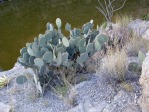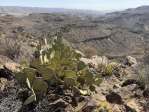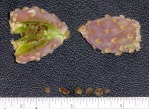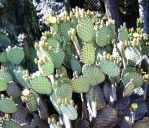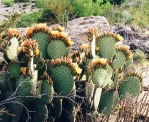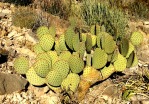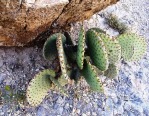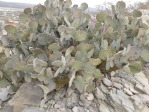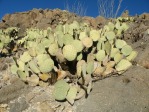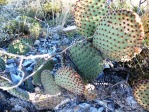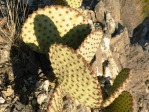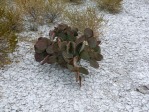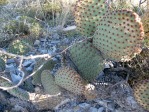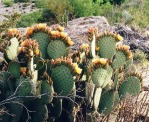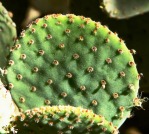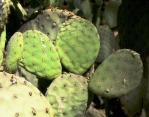
Engelmann, Proceedings of the American Academy of Arts and Sciences 3: 298, 1856
Herbarium; Herbarium; Herbarium; Herbarium; Herbarium; Herbarium; Herbarium; Herbarium
Original Description
What is Opuntia rufida?
Opuntia rufida is a large, spineless pricklypear cactus that occurs in the Big Bend area of Texas and south into the greater Chihuahuan Desert of Mexico.
Details
O. rufida is a much-branched cactus that may reach 1 to 1.5 m and a bit wider. The plant generally has a short trunk, and pads are subcircular, obovate, or elliptical, 8 to 25 cm across. The pads are thickish and tomentose. Areoles are spineless but are conspicuous with tufts of red-brown glochids.
The flowers are yellow to orange and 4 to 5 cm long, including the ovary. The filaments are greenish-white, and the style is 1.5 cm long and bulbous above the base. The fruit of this Opuntia is bright red, umbilicate, and globular.
O. rufida is diploid.
See Köhler al., 2023.
Other Notes
Britton and Rose reported that this species is less common than, and is sometimes confused with, O. microdaysys, another spineless pricklypear sympatric with O. rufida in Mexico. However, the glochids of O. microdasys are generally pale. Also, unlike O. microdasys, O. rufida has reniform to circular cladodes. Moreover, O. microdasys is typically a shorter plant.
Though the flowers of this Opuntia are not especially memorable, O. rufida is statuesque and unique in appearance. It would be a spectacular garden plant except for the profusion of glochids. This pricklypear sheds its glochids with abandon, and they are a menace to any gardener. Whether true or not, its glochids have the reputation of detaching and flying on the wind. Flying glochids are anecdotally reported to blind humans and animals, hence the name, blind pricklypear.
For more information, see:
Köhler, M., Reginato, M., Jin, J.-J., and Majure, L.C. (2023) More than a spiny morphology: plastome variation in the pricklypear cacti (Opuntieae). Annals of Botany, 132(4), 771–786.
GenBank locus NC_083952.1.






